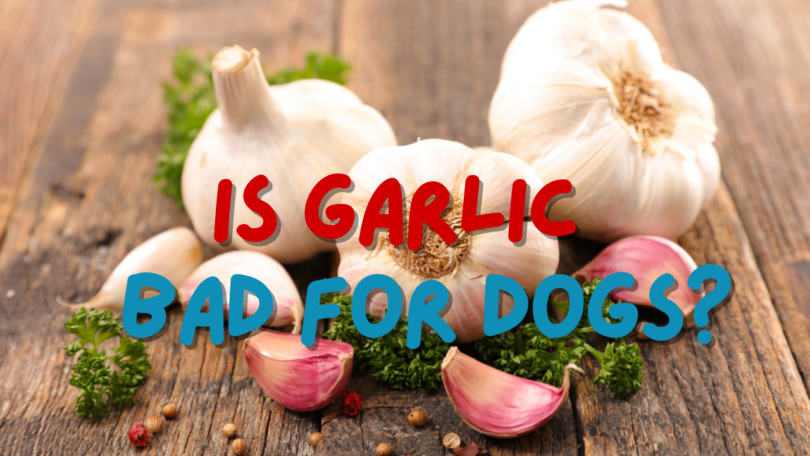As a dog owner, you might have wondered whether garlic is safe for your furry family member. After all, garlic is a common ingredient in many human foods, and some even believe it offers health benefits. However, the truth is that garlic can be harmful to dogs due to its toxic compounds.
Dogs metabolize garlic differently than humans, which makes it potentially dangerous. Garlic contains thiosulfate, a compound that can damage your dog’s red blood cells, leading to conditions like hemolytic anemia. Even small amounts can cause harm, so it’s crucial for pet owners to stay informed.
This article will guide you through the signs of garlic toxicity, safe dosage guidelines, and what to do if your dog accidentally ingests garlic. We’ll also explore the importance of consulting a vet and provide expert advice to keep your dog safe and healthy.
For more information on pet health and safety, visit PetHonesty and DogTips for reliable resources.
Understanding Garlic Toxicity in Dogs
Garlic, a common ingredient in human cuisine, can be harmful to dogs due to its toxic compounds. As a pet owner, it’s crucial to understand why garlic poses a risk to your dog’s health.
What Makes Garlic Harmful?
Garlic contains compounds like thiosulfate, which can damage your dog’s red blood cells. This damage can lead to conditions such as hemolytic anemia. Garlic belongs to the Allium family, which also includes onions, leeks, and chives—all of which are toxic to dogs.
How Garlic Affects Red Blood Cells
When a dog ingests garlic, the thiosulfate in it causes oxidative damage to the red blood cells. This damage can disrupt the cells’ ability to carry oxygen, leading to anemia. Even small amounts can be harmful, especially to sensitive breeds.
Similar to onions, garlic’s toxicity can vary, but both can cause significant health issues. If you suspect your dog has ingested garlic, it’s essential to consult a veterinarian promptly to prevent severe complications.
Recognizing the Signs and Symptoms of Garlic Poisoning
As a responsible pet owner, it’s crucial to identify the signs of garlic poisoning in your dog promptly. Garlic toxicity can manifest through various symptoms, which may worsen over time if left untreated.
Common Symptoms to Watch For
Your dog may exhibit several symptoms if they’ve ingested garlic. Common signs include vomiting, diarrhea, lethargy, and pale gums. These symptoms often start within 24 hours of consumption but can sometimes take up to a week to appear.
Other indicators of garlic poisoning include abdominal pain, drooling, and rapid breathing. In severe cases, your dog may develop dark urine or jaundice, which signal serious health complications.
When to Seek Veterinary Care
If you notice any of these symptoms, especially if they worsen, contact your vet immediately. Early intervention is key to preventing severe health issues like anemia or organ damage.
Monitor your dog closely, even if they seem fine initially. Small amounts of garlic can still cause harm, and symptoms may develop gradually. If unsure, consult your vet for professional advice.
How Much Garlic Is Toxic to Dogs?
Understanding the toxic dose of garlic for dogs is crucial for every pet owner. Garlic belongs to the Allium family, and its toxicity varies based on your dog’s weight and the amount consumed.
Determining the Toxic Dose by Weight
Studies show that 15 to 30 grams of garlic per kilogram of your dog’s body weight can be harmful. To put this into perspective, one clove of garlic typically weighs between 3 to 7 grams. For a medium-sized dog weighing around 25 pounds (approximately 11.3 kilograms), consuming about 10 cloves could require veterinary attention.
It’s important to remember that even small amounts of garlic can accumulate to toxic levels if your dog eats them over several days. This makes it essential to monitor any food your dog consumes, especially if it contains garlic. Always double-check the calculations with your veterinarian to ensure your dog’s safety.
The risk of garlic toxicity increases with the amount and frequency of consumption. While slight exposure may not cause severe symptoms, crossing the toxic threshold can lead to serious health issues like anemia. If you suspect your dog has ingested garlic, contact your vet immediately to prevent complications.
is garlic bad for dogs: Debunking Myths and Facts
When it comes to your dog’s diet, it’s natural to question whether certain human foods are safe. Garlic, in particular, has sparked debate among pet owners. While some believe it offers health benefits, scientific evidence tells a different story.
Comparing Raw versus Cooked Garlic
Raw garlic is more potent and toxic to dogs than cooked garlic. Cooking reduces the concentration of harmful compounds, but it doesn’t eliminate them entirely. Even in small amounts, garlic can accumulate and cause health issues over time.
For instance, a study by K W Lee et al. (2000) found that dogs fed 5 grams of garlic per kilogram of body weight showed significant health risks. This translates to about four full heads of garlic for a 75-pound dog. While this seems like a lot, even smaller amounts can be dangerous, especially for smaller breeds.
Myth Versus Scientific Evidence
Some websites claim that garlic can repel ticks or improve cardiovascular health in dogs. However, these claims lack robust scientific support. Studies repeatedly show that garlic belongs to the Allium family, which is toxic to dogs due to compounds like thiosulfate.
Garlic’s toxicity is dose-dependent. For example, a 10-pound dog would need to consume about 67–135 grams of garlic (13–27 cloves) to reach toxic levels. However, even smaller amounts can cause oxidative damage to red blood cells, leading to conditions like hemolytic anemia.
It’s important to remember that garlic’s benefits for humans don’t translate to canine health. Always prioritize scientifically backed advice and consult your veterinarian before introducing new foods or supplements to your dog’s diet.
For more information on garlic toxicity and safe dietary practices, visit Volhard Dog Nutrition for expert advice.
Considering Garlic Supplements and Alternatives for Dogs
While some pet owners explore garlic supplements for their dogs, it’s important to approach this topic with caution. These supplements are often marketed for benefits like flea prevention or immune support, but their efficacy and safety are debated.
Pros and Cons of Garlic Supplements
Some studies suggest garlic may help reduce flea infestations, but these findings are not conclusive. On the flip side, incorrect dosing can lead to toxicity, making professional guidance crucial.
Veterinarian Recommendations for Safe Alternatives
Vets often recommend safer alternatives like flea medications or natural deterrents. If considering garlic, consult your vet to ensure safe usage and proper dosing.
Always choose products specifically made for dogs and consult your vet before adding any supplement to their diet.
Special Considerations for Sensitive Breeds and Health Conditions
When it comes to your dog’s health, certain breeds and pre-existing conditions require extra attention, especially when it comes to garlic. As a pet owner, understanding these specific needs can help protect your dog from potential harm.
Breed-Specific Sensitivities
Some dog breeds are more sensitive to garlic’s effects. Breeds like the Japanese Spitz and Shiba Inus may experience more severe reactions. Even small amounts can lead to significant health issues in these sensitive dogs.
For instance, a small “dog eat” portion of garlic might be risky for these breeds. If you own a sensitive breed, it’s crucial to monitor their diet closely to prevent any adverse effects.
Interactions with Medications and Pre-existing Conditions
Dogs on certain medications, especially heart medications or blood thinners, face higher risks when exposed to garlic. These interactions can lead to serious complications, making it essential to consult your vet before any exposure.
Pre-existing health conditions can also heighten the risk of garlic poisoning. If your dog has a known medical condition, it’s vital to be cautious and seek professional advice to ensure their safety.
Always prioritize your dog’s health by being mindful of their unique needs and sensitivities. Consulting with your veterinarian is the best way to keep your furry friend safe and healthy.
Safe Serving Practices and Dietary Guidelines
When considering garlic in your dog’s diet, it’s essential to handle it with care. Proper preparation and accurate dosing are crucial to avoid toxicity.
Proper Preparation of Fresh Garlic for Pet Use
Start by crushing fresh garlic cloves. Let them sit for about 10 minutes to release beneficial compounds. This step is vital for potency but remember, even small amounts can be harmful.
Establishing Safe Dosage Guidelines
Dosing depends on your dog’s weight. As a rule, 15-30 grams per kilogram is toxic. For a 25-pound dog, 10 cloves could be risky. Always measure cloves accurately and consult your vet for precise guidance.
Some owners use garlic to repel fleas, but caution is key. Monitor your dog’s reaction and consult a vet before any dietary changes. Prioritize your dog’s health with careful planning and professional advice.
Wrapping Up Your Pet’s Garlic Guidelines
Garlic can be harmful to your dog due to its toxic compounds, even in small amounts. Understanding the risks and taking preventive measures is crucial for your pet’s well-being.
If your dog ingests garlic, watch for symptoms like vomiting, diarrhea, lethargy, and pale gums. These signs can indicate poisoning and require immediate veterinary care. Prompt action is essential to prevent severe health issues.
While some believe garlic offers health benefits, the risks of poisoning outweigh any potential gains. Always consult your vet before introducing garlic into your dog’s diet.
For more information on keeping your dog healthy, visit DogTips for expert advice. Remember, informed decisions and cautious approaches ensure your pet’s safety and happiness.
FAQ
What makes garlic harmful to dogs?
Garlic belongs to the Allium family, containing compounds that can damage a dog’s red blood cells, leading to anemia. These compounds disrupt the cells’ ability to carry oxygen.
How does garlic affect a dog’s red blood cells?
Garlic’s compounds can cause red blood cells to rupture, a condition known as hemolytic anemia. This reduces oxygen transport in the blood, potentially leading to health issues.
What are the common symptoms of garlic poisoning in dogs?
Symptoms include vomiting, lethargy, and lack of appetite. In severe cases, dogs may show pale gums, rapid breathing, or even collapse due to anemia.










Leave a Comment